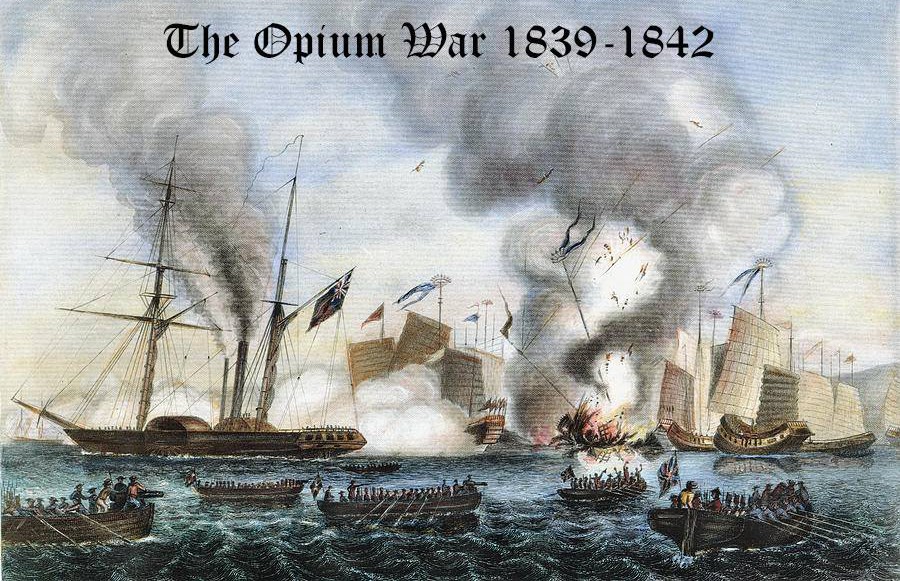By Seonyeong (Anes) Lee
China
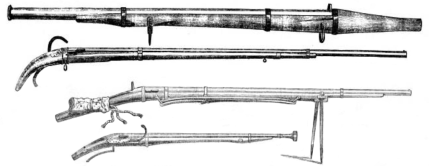
In the Opium War, the military of Qing used shotguns, which had a length of 2.01meters with a range of around 100meters, and firing rate of 1-2 rounds/minute. The shotguns were excessively old in technique because they were actually from Ming dynasty. They didn’t operate properly (Sino-British Opium War Weaponry Comparison). Furthermore, there were not enough shotguns the military could use. Instead, the Qing army used spears and crossbows. Technology of artillery was also poor (Do 17). Irons for making artillery were impure because temperature for smelting was too low, which made the artillery rough. Besides, formulations of gunpowder were carried out based not on the exact calculation but on crude experience. At that time, Great Britain made gunpowder with 75% for NOx, sulfur 10% and charcoal 15%. Gunpowder of the Qing was difficult to store for long time and explosive power was weak. Also, they used War Junks which definitely depended on wind. The War Junks were made by wood, which were much weaker than British’s.
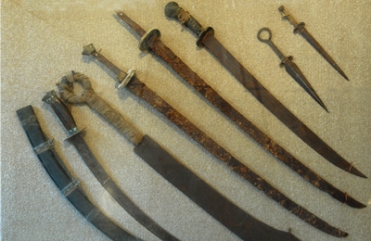
These poor weapons show the situation of the Qing in the 19th century. Chinese did not recognize their technologies and social systems were behind of the development of the Western world. The first Opium War for 1839~1842 was enough to shock people who believed their country was the best in the world. China had controlled the East Asia with its huge territory, a great number of populations, and systematic studies from ancient time. From the point of view of China, the Opium War was a conscienceless attack of the United Kingdom and this perspective is well reflected in a textbook for school until now. The textbook for Chinese history describes China as an innocent victim, on the contrary it introduce the United Kingdom as a greedy nation with ambition to expand their markets for capitalism (Kim 2). It tries to hide their shortcomings and emphasizes the attack from the United Kingdom (Kim 2).
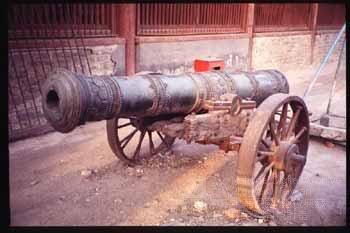
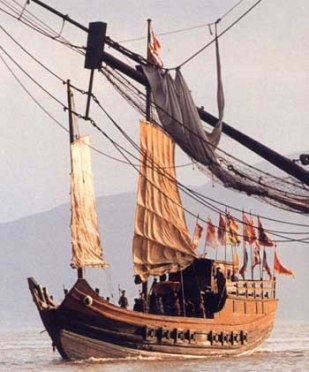
The current generation can find implications with the social confusion China experienced in the Opium Wars. When the United Kingdom modernized its weapon, and strengthened its army and navy, China had a stronghold of conservatism. China neglected foreigners and did not submit to the British’s superiority, yet the country was obsessed about its past glory (Kim 13). What China needed to do was to upgrade its national competitiveness, learning better techniques. I’m not saying the Western civilization was better than the Eastern in all ways. The point is that it is really important to learn new knowledge and technologies and make mastery of them. To maintain a prestige as a powerful nation, it is required to accept its insufficiencies modestly and to try to learn progressively.
The United Kingdom

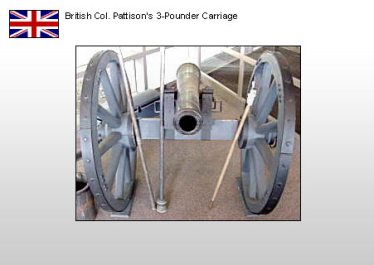
The United Kingdom used Burke-style muzzle-loading smoothbore flintlocks, which had a length of 1.16 meters with a range of about 200 meters and rate of fire of 2-3 rounds/minute (Sino-British Opium War Weaponry Comparison). Strong points of the United Kingdom were in artillery and gunboats. The Industrial Revolution after development of method of iron smelting made it possible to produce pure iron. The United Kingdom used various sizes of components and reasonable designs for operating artillery to make high accuracy. By the end of 16th century, the Royal Cannon appeared, which turned the scale at 6 tons and could fire cannonball of 75 pounds (Do 13). In addition, the British navy ranked the highest in the world at that time. The gunboat named Nemesis had a length of 56 m, a beam of 8.8 m, a draught of 1.8 m, and a burthen of 660 tons. It was operated by two sixty horsepower Forrester engines. It was armed with two pivot-mounted 32 pounder and four 6 pounder guns, and a rocket launcher. Initially the British warships were sailing warships that couldn’t penetrate shallow, inland waterways. So, the British made a war along the coast. However, the Nemesis allowed the military to attack China much aggressively. In January 1841, they destroyed the Chinese forts which sheltered the passage of the port of Canton. Cities were attacked by the Nemesis and its technological innovation such as the Congreve rocket (Weapons and Warfare).

These outstanding weapons reflect the development of the United Kingdom and Western civilization in 19th century well. The weapons the United Kingdom used were symbols of European modernization and an awareness of superiority to Eastern civilization. The United Kingdom needed a bigger market to accommodate capitalism, and China was good enough to achieve its goal (Opium Wars). According to John Ouchterlony, who participated in the first Opium War as one of the British air force officers, explained the longstanding political conflict that caused the war, omitting a hidden intention of the government (Ouchterlony 8). He mentioned that the Chinese government was dissatisfied with the surplus of the United Kingdom in the opium trade and treated the British products rudely (Ouchterlony 9). Ouchterlony insisted that it was the Chinese’s fault to develop addiction in opium and they strongly demanded opium without any coercion from British merchants. He thought the war was reasonable to protect British people (Ouchterlony 9), and this perspective lasts until now, as reflected in textbooks for school. The textbook saw the war as a result of conflict between two civilizations in economic relationship without explaining the government’s attitude in detail (Kim quoted in Mitter 21).
The significant lesson from the attitude and the perspective of the United Kingdom toward the Opium War is a proper attitude toward other countries which have different civilization. It is obvious that the United Kingdom had a better scientific technologies and developed systems, but it does not mean that a stronger country can abuse their power toward weaker countries to fulfill its greed. Therefore, it is a remaining task to clarify ways to coexist among various countries nowadays in politics and economy. The Opium War by the assembly of the United Kingdom could be the optimal choice for the nation and the people at that time. However, as generations who live in an era which requires obvious international standards as regimes in globalized age need to evaluate their historical decision honestly.
Reference
Do Hyunsin. Amazing World History. Seoul: West Sea Publication, 2012. Print.
Illustrated London New 1841. Web. Nov 19, 2014. http://commons.wikimedia.org/wiki/File:Opium_War_weapons_1841.png
Kim Eunkyung. “Comparion and analysis on the descriptions of the Chinese • the United Kingdom’s history textbooks of middle school about the first Opium War.” Diss. Ewha Womans University, 2009 Online.
Kim Joosam “An Analysis of the Process of Modernization in East Asia and the Corresponding changes in China and Japan after the Opium Wars”, Asian Study11.3 (2009). The Korean Association of Philippine Studies. Web.
MLBPARK. Web. Nov 19, 2014. http://mlbpark.donga.com/mbs/articleV.php?mbsC=bullpen&mbsIdx=240079&cpage=&mbsW=search&select=stt&opt=1&keyword=%C3%BB%B1%BA
Opium Wars (1839-1842, 1856-1860). Weapons and Warfare, 24 June 2011. Web. Nov 19, 2014,
Ouchterlony, John. First Anglo-Chinese War. Seoul: Upaper, 2013. Print.
Sino-British Opium War Weaponry Comparison. Research Paper Center, 16 Jan. 2006. Web. Nov 19, 2014.
The army of Qing dynasty. Web. Nov 19, 2014. http://www.twcenter.net/forums/showthread.php?365893-The-army-of-Ming-Dynasty-and-Joseon-Dynasty-during-the-16th-century
Total War Center. Web. Nov 19, 2014. http://www.twcenter.net/forums/showthread.php?365893-The-army-of-Ming-Dynasty-and-Joseon-Dynasty-during-the-16th-century
Zhenhai Coastal Defense History Museum. Web. Nov 19, 2014 http://www.zhkhfsg.com/en/products_detail.asp?id=995&cataid=139

